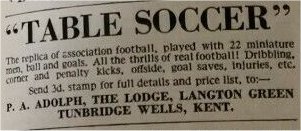
| Peter Upton's |
Subbuteo Tribute Website. |
Focus On.... |
Thanks mainly to collector Ashley Hemming, I have been able to update the website with details of the early years of Subbuteo. However, this information is spread around various sections of the website - history, box sets, accessory lists, team lists etc. The purpose of this page is simply to bring that information together in one place. It is a much-told story how Peter Adolph advertised his table soccer game before he had actually produced it. So it is unsurprising that the first few years see a lot of tweaks and changes as he refined the game, and as feedback came in.
Adolph produced regular updates and price lists, which were based around the standard English Football season i.e. August - May. It therefore makes sense to divide this page into seasons, and look at what was produced during each one.
The 1946-47 Season

Although Peter Adolph had clearly done some work on his game prior to August 1946, the start of this season saw the first two recorded instances of the game. The first advertisement for his soccer game appeared in the August 1946 issue of "The Boy's Own Paper", and his seven page patent application for the game was dated August 9th in the same year.
The oft-told tale is that Peter Adolph placed the first advert "to test the market" for a product he had not created. However, the patent document shows that he had actually been working hard on the game. Even this early in development were recognisable Subbuteo elements like Shooting areas (although originally curved), and an instruction to play the ball with the same player "no more than three times in succession". In addition, a player taking a throw in could not cross the touchline, and there was a positioning flick for corners and throw-ins.


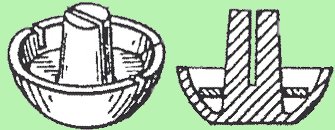
Peter Adolph's lovely illustrations of the playing equipment in the patent show some of the designs used in the original sets, both with respect to the players and in the construction of the goals. Clearly he had produced a prototype game, and had been playing it (a lot) by August 1946.
The one item that was lost somewhere between the patent and the final product, was a wooden spoon, which was to be used to flick the players. Adolph did not illustrate this (it was just an ice cream spoon), but he had tested it, remarking that the handle was better for longer, harder flicks, whist the curved spoon allowed chipping. Somewhere between patent and production, it was worked out that using a finger was far more responsive.
The one thing Adolph had not given enough thought to was production. It makes for a less exciting tale, but it was this (rather than any game inventing) that caused the delay between original advert, and final launch.
In the early days, Adolph was also running a "natural history" business, and he was in American evaluating an egg collection, when the replies to his advert came through. There were so many responses, that his mother had to cable him to ask what she was supposed to do. Peter Adolph cut short his trip, and headed home to start production. In his book, Adolph's son Mark tells how his father, grandmother, and a friend named Jim Murphy turned a spare bedroom in the Adolph house into a production centre. With shortages still in place after the Second World War, and little experience, it was not an easy task.
The Original Subbuteo Set - March 1947.
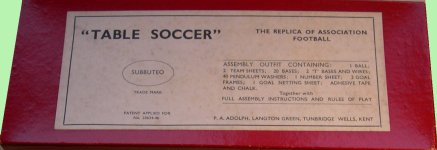
This is the product that Peter Adolph finally launched in March 1947, over six months after his initial advert. This basic first product needed a ball, two teams, two goals, and a pitch to play on (and the box....). Obviously, providing the pitch would have been prohibitive in both cost and size, but the patent application mentioned marking out the pitch with "French Chalk", so clearly that was not going to be a problem. Everything else turned out to be very similar to the original patent designs.
Pleasingly, this first set does use the word "Subbuteo", which is introduced as a trade mark. Mind you, it only featured on the box, and delivery note, and the logo was very basic. Subbuteo was not mentioned anywhere on the rules, which simply called the game "Table Soccer". This helps to explain why Adolph's simultaneously launched club for players was simply called the "Table Soccer Players Association". The box also stated "Patent applied for No 23634-46".
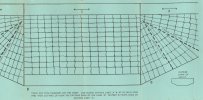
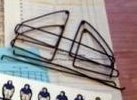
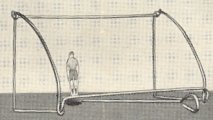
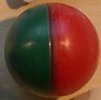
The goals produced were already in the patent, and were simply copper wire frames with nets printed on blue paper. This goals remained unchanged in the basic set right through the 1950s. In these early sets, adhesive tape was provided to fix the nets to the frames. Simple frames, but complicated sounding instructions...
"Goal Frames. Arrange one of the wire frames so that the shape coincides with the pattern printed below. Bend the frame down a quater inch from the end of the left side (as directed by arrow on the pattern), gently raising the part of the frame marked 'A' on the pattern, upwards and in the direction of the left until it is upright. Repeat with the part marked 'B' on the pattern, only this time raise in the direction of the right. Carry out the same procedure with the remaining wire goal frame and you will have two skeleton goals. Finally, insert the separate wire pieces into the holes of each skeleton from within the goals to act as crossbars.
Goal-Netting Sheet. Cut the designs out as directed on the sheet, cutting up from the extreme ends of the lines 'B', to meet extreme ends of outside lines 'A', and fix the front edge of the crossbar of one, to the corresponding section on the goal skeleton. Cut a length of self adhesive tape, 5ins long, and place an edge along the arrow on the crossbar design (1). Fold underneath the goal skeleton crossbar, and press the tape to stick securely. Cut two pieces of tape, 2.25ins long: cut another 4.5 ins long. Secure the goal posts (2) with the two former strips, and the back of the goal (1), with the latter; in a similar manner as the crossbar was secured; having folded the sides of the design as directed thereon. Repeat the same procedure with the remaining goal design and skeleton."
That sounds much more complicated than it is... It also is the longest part of the rule book!
The balls were acetate, and easily sourced, probably from blow-football suppliers*. The original ball was a smooth two-tone affair coloured green and red, and these balls also occasionally feature in Newfooty sets of the era. However, Adolph's preference was for a realistic brown panelled ball, and these were certainly being used later in the 1940s. (Adolph began offering two colour balls, rather informally, in the accessory lists of the 1950s. I've never seen one in a set/collection though).
*I've no evidence for this beyond the fact that the same size and type of ball does appear in blow football sets of this vintage.
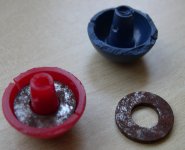
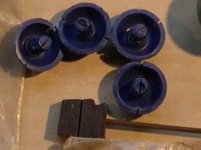

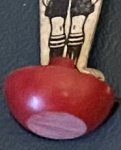
The problem (in the time available) were the playing figures. Both card player, and plastic base proved tricky to produce. In his original version of the game, Adolph had constructed the bases from a coat button of fortuitous design, acquired from Woolworths (possibly from a coat owned by his mother). This was weighted with a "pendulum washer", and the design can clearly be seen in the patent drawings. I think the plan was always for Adolph to produce his own bases, but knowing that he could not get these moulded in time, Adolph simply made a big order of buttons from Woolworths, and set about converting them. The pictures above show the result. You can clearly see the button hole!
This is the only set that has these original bases, and Adolph produced his own design as soon as possible. Therefore this is also the only set to feature "40 pendulum washers" on the content list. These neatly fitted into the base to provide much needed weight.
The goalkeeper handle was described as a "T-base and wire". Unlike the patent, the goalkeeper base is not rectangular, but has a rather fancy design. There is nothing else fancy about this set, so this item could also be converted from another use.
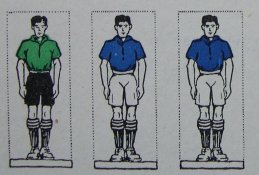
Returning to Mark Adolph's book, it is explained that getting the card playing figures manufactured was actually the slowest part of the process. They were eventually produced by Petty and Company in Leeds. They were a simple black and white illustration printed with red or blue shirts. The players were charmingly hand-drawn in a "comic book" style.
The rule book in this original edition included the assembly instructions, and it is worth quoting here for Peter Adolph's official way of cutting out the figures.
"Team Sheets. The figures in green shirts are the goal-keepers. Cut along the dotted lines around each figure so that there are eventually twenty-two oblong pieces. With a small sharp pair of scissors cut very neatly around the football player figures themselves. Be most careful to leave the half-inch long stripes underneath the boots of the figures. Remove any roughness along the edges with a nail file."
The rest of the paperwork was printed by Harding and Curtis Ltd, Bath. This included the all important four page rule book, plus despatch note, and sticker sheet to identify the players.
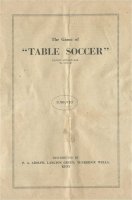
The original rule book was a very plain affair. It was a single sheet folded into four sides. Take out the simple front page, and you have just three pages of assembly instructions and rules. If you are keen to read the original rules, you have a couple of options. I quote from them at length onRule Books - Page1. Alternatively, just pick up any basic playing instructions leaflet from the 1950s, as the rules remain pretty much unchanged throughout, with only the curving shooting area getting dropped. In fact, the rules are recognisable right into the late 1960s.
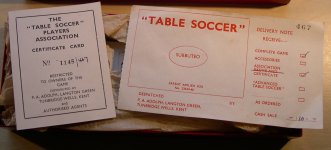
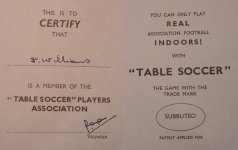
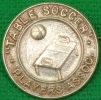

The other "item" to be launched with the game was the "Table Soccer Players Association". This was a way for Peter Adolph to keep in touch with his players, and to form a community. All members received a membership card and a club badge. Well, eventually they received a badge. Like everything else, the badges were delayed, and Peter Adolph had to send out a typed apology using the 1947 Fuel Crisis as a convenient excuse.
Although he had to struggle with complaints about the delay, the end product seems to have been a success. Nearly four hundred owners signed up for the Association between the launch in March and the end of May 1947. The original owner of the set illustrated (F Williams from Cardiff) was one of these early members.
The 1947-48 Season
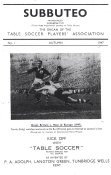
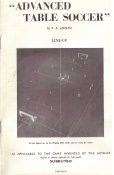
This was the first full season for Adolph's Table Soccer, and saw increased use of the "Subbuteo" trade mark. The name finally made its first appearance in a "Boy's Own" advert in September 1947, and was also used as the title of the first issue of the Table Soccer Players Association journal. Peter Adolph was still calling the game "table soccer" in this leaflet, but the journal is named "Subbuteo", with trade mark registration pending.
The aforementioned TSPA journal, dated Autumn 1947, is full of useful information for the historian. Here, Adolph mentioned many new accessories for the game, although he has not started to number the range. The item that received the most attention was his new booklet called "Advanced Table Soccer", available for a shilling. This slim volume had pictures and discussions on the propulsion of figures, tactics, etiquette, and advanced rules such as offside.
The original version of "Advanced Table Soccer" is now illustrated above, again with little Subbuteo branding. From the second edition (shown further down the page), this booklet gained a smart red cover, which lasted throughout the 1950s. Here though, was another plain white leaflet, with a rather dull "line-up" picture on the cover. Inside were various sections expanding on various aspects of the game, all described in a very sensible and serious manner. If at this point you are thinking it would be interesting to read Adolph's early thoughts on the game, then don't worry - you can.... I have a 1967-68 version of the Advanced rule book sitting on my lap as I write this, and most of the content is identical to the 1947 version. We have a foreword; the valuable hints in setting out the game; propulsion; tactics; your team as your favourite club; leagues; and finally the advanced rules. It is really only this final section that changed and expanded - with complicated "complete playing rules" arriving in the early 1950s. Most of the rest is word for word with the 1947 version.
Back in 1947, the advanced rules only covered three areas, goal scoring, off-side, and goal-keeping. The semi-circular shooting areas were replaced by an invisible line, half-way between goal and half-way (I believe Adolph could not get the curved lines printed onto a pitch), but in this period, you could actually score from your own half (never mind the shooting area), if you followed this Byzantine rule....
"If from your own half of the field, you propel the ball swiftly towards your opponent's half, and the ball hits any figure in his half and subsequently enters between the goal posts, a goal is only counted if the figure is nearer to the goal-line at the time of the conclusion of the shot, than to the half-way line." Clear? The Etiquette section advised that you had to warn the opponent if you were trying this (or indeed shooting in general).
The offside rule was introduced here, but only applied in the shooting area (as it does to this day). A modern-sounding "interfering with play" rule also applied, where the figure was only offside if playing the ball, having the ball played to him, or was nearest to the ball when it had stopped.
The advanced goalkeeper rules allowed the keeper to "touch the ball from any spot where he can reach whilst on the wire, but must not be used in billiard cue fashion in order to hit the ball. Instead, he may be taken off the wire holder and flicked against the ball by the usual method. (He) may only play the ball twice in the penalty area, and once outside. Should he miss the ball whilst off the wire.... (he) may only resume his correct position when the opposing side finish their immediate play." Is that one flick or the whole play until possession is lost?
The "Your team as your favourite club" section showed Great Britain vs Rest of Europe (1947) as the example.
Perhaps the most interesting additional information in this leaflet, is in the "valuable hints in setting out the game" paragraph. This starts normally - "Green cloth similar to that used for Billiard Tables is the most effective material on which to play", but then it states "alternatively, a green plastic cloth, details of which you will find in the inserted Price List". Hold on.... Plastic? What was this early attempt at an official pitch? Think we better look at that 1947 price list! See below for details.

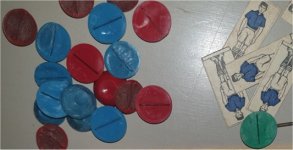
More important than the Advanced rules, but given far less fanfare, the journal announced that the button bases were being replaced by "super flattened bases scientifically designed", in the shape and style familiar to all collectors and players. These proper bases made the game look much more professional. The one-piece design also meant that Subbuteo did away with washers as weights (at least until the heavyweight era!). The bases were originally produced in red, blue, black and white for teams, with green and yellow for goalkeepers. This saw another early change, with the old 'T' base for goalkeepers retired. This allowed the goalkeeper to be removed from the rod in order to play the ball in the normal manner.
The first issue of the new bases were plain, with no name on the top surface. The Subbuteo named versions arrive by 1949-50. The plastic used in the early bases must have been of a different type to the later versions, and sixty years later, they are breaking down badly. This "blistering" continues into the early named bases (as shown above), although in my experience, the blue and green bases suffer much more seriously than the red bases.
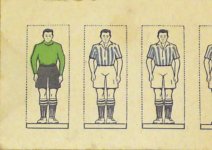
Other early accessories advertised in the TSPA journal were "team sheets in the majority of League club colours", (although no examples are given, and the 1947 catalogue gives 10 references, but only 9 different kits), real netting for the goal frames (became Set I), and playing pitch cloths. The second edition of the journal (dated Winter 1947/48) had less of interest, but suggestions from players in this booklet helped Adolph fill out the accessory range. R. Nicholson pointed out that "spare goal-keeper figures would be of assistance in order always to have a rigid figure in the 'T' base and thus keep an important defence in good trim". Bent card 'keepers were always a problem, and Adolph replied that "the current price list details special goalkeeper sheets", which became Set H. Another player, Geoffrey Bush, was using cork and drawing pins to hold his goals securely in place. Adolph launched his own "goal holding device" the following year.
The Amended Assembly Outfit - Autumn 1947.
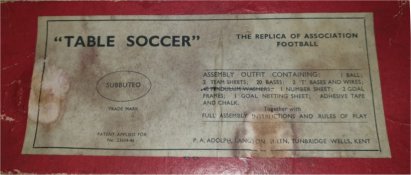
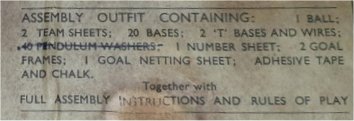
As soon as Peter Adolph's own plastic bases were available, the boxed set was amended to cater for them. collector Stuart Phillips owns this set from Autumn 1947, which shows that the original set was amended prior to the "proper" 1947-48 edition being produced. As the new "super flattened bases" did not need a pendulum washer, this was deleted (with a pen) from the contents on the lid. The instruction booklet was also amended with new assembly instructions printed up and glued into the original book. Otherwise, the set seems identical to the March 1947 issue.
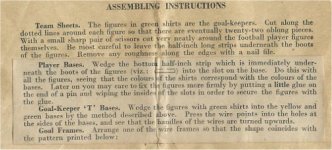
This set had a price list dated to Autumn 1947, which numbered the range for the first time. I had never seen this leaflet before, and it has caused me to move some of the dates around on this page. The TSPA leaflet actually mentions this item with regard to the "plastic pitch", so the two items were close in date.
The 1947-48 Set.
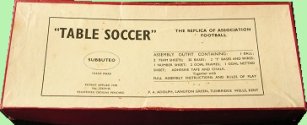
Once his original stock had been exhausted, Peter Adolph could re-print his set to account for the change in base type, and other developments. This brings us to the proper 1947-48 edition. The contents list on the lid now just shows the bases, with no pendulum washers. However, the set does still list "T-bases" for the 'keepers, and does so for a few more sets. However, this now just described the normal round bases on a rod. Making a "T" I suppose, but it confused me for ages when I was first aware of the early keeper bases. Adolph also states that his Patents are now pending, and bases are "protected by British Registered Design No 851000".

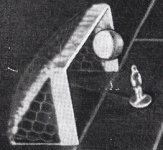
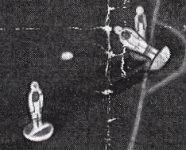
The 1947-48 rule book (and picture).
The rule book needed a proper re-write to cover the new bases. In this second edition, the Subbuteo name is higher profile, although the words "Table Soccer" are still much bigger than the trademark. For this more deluxe booklet, the cover featured a photograph of the game in action. This is the earliest published close-up of the contents of the game that I am aware of, and is therefore quite important. Some of the detail is shown above. This is clearly Peter Adolph's own set, and at first it seems a standard Subbuteo scene, but there are oddities. The most noticeable thing for me was always the hand-drawn players, that suggest a really early date (after all, it took several months for the teams to be printed). However, I concede that the picture might have been "touched up" to make it clearer, an old trick of the time. This looks more likely on my magnified close-ups than on the original cover.
Now we have seen the 1947 price list, the rest of the contents here make more sense as being from the second year of the game. We have the super-flattened bases, and the goalkeeper on a round base, not a T-base. The goal has been improved with Peter Adolph's original "real netting" accessory, which was Set I. Ashley Hemming tells me that the heavy white material across the posts, crossbar, and back bar, is the original Hessian type material which was used prior to the more familiar acetate piping. The pitch is Adolph's own hand-drawn version, but no printed pitch was being offered for sale at this time, only the materials to mark it up on.
The pitch, goals and ball all reappear in the 1948 Schoolboys' Own Exhibition pictures. However, a close-up of that event on the 1949-50 "Spin" leaflet clearly shows standard players, not the hand drawn ones.
This action picture was actually retaken for the 1949-50 version of the rules, using the standard equipment of that period - the acetate piping on the goals, and a brown ball. (see that season for details).
Autumn 1947 Price List.

This season saw the production of the first full "price list of accessories and components". A list continued to be produced at least annually from this point onwards, and was always included in Subbuteo sets. This obviously makes dating Subbuteo items much easier. The original list was laid out in alphabetical order, and reached Set "L". The accessories are dealt with elsewhere on the site of course, but it is worth a quick description of the first list here.
Set A: The Complete Game Set (10s 1d)
Set B: Subscription to the Table Soccer Players Assn (badge, membership card and eight page bulletin).
Set C: Advanced Table Soccer booklet (1s)
Set D: One Team sheet, 10 super flattened bases, 1 number sheet, goalkeeper base and wire handle (3s 8d)
Set E: Two goal frames, 1 netting sheet, self-adhesive tape. (1s 10d)
Set F: Two Super Balls (11d)
Set G: Two special team sheets, One number sheet (1s 2d)
Set H: Two special goal-keeper bases and wire handles (11d)
Set I: Real Netting for fixing to both goals, together with white adhesive tape (1s 2d)
Set J: Two goals with crossbars (1s 3d)
Set K: Green plastic sheeting for converting into a Playing Pitch Cloth 54" x 36" together with 11 yard roll of white tape for marking touch lines, and full instructions (14s 0d)
Set L: Green imitation baize sheeting for converting into a Playing Pitch Cloth, 54" x 44", together with full instructions for marking (7s 6d)
For those of us who have a number of later price lists, the one thing that is noticeable is the constant set number/lettering. This is especially true when compared to rival Newfooty, which constantly renumbered their range. However, in this first list there are several numbers that get quickly changed. (Set E became a set of bases, Set H became the goalkeeper figures rather than the bases, K became the baize pitch, and set L became the card referee set).
Of course, the stand-out oddity in this range is the "Green Plastic Sheeting" offered as an alternate pitch. We are so used to Subbuteo being played on a baize pitch, that this seems bizarre. You can't even call it the cheap option, as it cost twice the price of Adolph's "imitation baize sheeting". However, even that might not be our usual baize. The baize pitch advertised by 1949 was much more expensive (13s 6d), and that cloth was improved again in 1953. We really need more details of all these early pitch options.
The price list finished with a simple table of the club colours which were available as extra teams (references D and G). Again, this is the start of a continuous numbered team list that existed up to 1996 (refs 1-4, and 6 were still offered in essentially the same colours right up to 1996). However, this list does have a couple of unexpected colours...
Red shirts: White shorts.
Blue shirts: White shorts.
Blue and White striped shirts: White shorts.
Red and White striped shirts: White shorts.
Black and White striped shirts: White shorts.
Old Gold shirts: Black shorts
White shirts: Black shorts. (Goal-keeper in a Green jersey).
Black and White striped shirts: Black shorts.
Red and White striped shirts: Black shorts.
White shirts and Black shorts with the Goal-Keeper in a Yellow Jersey.
All the teams had goal-keepers in green jerseys, except for reference 10.
This list has two variations when compared to later lists. The early black and white reference five was previously known about, as it still existed on the 1948 price lists in the collecting community. However, this list has a white shirt/black shorts combo on reference seven, which had changed to the familiar claret with blue sleeves by 1948. It is odd that this duplicates with reference 10, albeit with a different goalkeeper. This might have been produced so that reference 10 was England (only international goalkeepers got to wear a yellow jersey in this period). Of course it makes sense that this was dropped (although perhaps surprising that ref 7 was changed rather than ref 10). The "super flattened" base colours were expanded to include gold for reference six.

The first Companion game, Soccer Market - "A football card game for the odd moment" was also released in this season, and advertised in the rule books. The first set used the clubs which won each of the four English divisions in 1947-48, which fortuitously, included the club Peter Adolph supported - Queens Park Rangers.
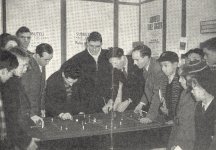
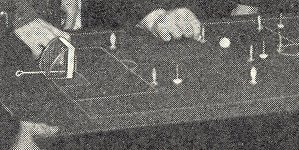
1948 also saw Subbuteo's first appearance at the Schoolboys' Own Exhibition, which was held at the New Horticultural Hall, in London, January 1st-10th 1948. It was obviously a big success, as Peter Adolph returned to the show every year until the early 1960s, and the Silver Cup competition was held there (along with a special "Open Competition"). The pictures from the original show, featuring Adolph and a few footballers of the day, appeared in Subbuteo paperwork through the 1950s. His advertising posters in these pictures show the Subbuteo name much more prominently than previous paperwork.
The 1948-49 Season
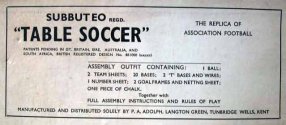
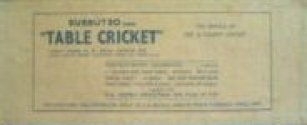
The third edition of the Assembly Outfit saw the registered "Subbuteo" name receive a bigger profile. As previously mentioned, the box still mentioned "T-bases" and wires for the goalkeepers, which was not strictly true. The companion range was expanded with the arrival of Subbuteo Table Cricket, first produced in January 1949. The two matching box lids are shown above.
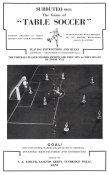
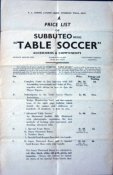
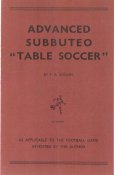
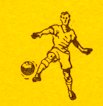
The rules sheet received an update too, and saw the first use of a "kicking footballer" logo. This logo made it onto the box by Spring 1949, and was also seen on Subbuteo's headed paper, the fixture cards, and even on the "white box" OO scale teams in the early 1960s, despite being replaced by a better version in the late 1950s. The new rule book advised that patents had been granted, although the rules were otherwise unchanged.
The Advanced table soccer booklet was given a second edition in the Autumn of 1948. This was the first version to get a professional looking red cover. Within were three additions to the rules by table soccer players, which were adopted for sectional league matches. The first gave a chance to flick the goalkeeper at any ball in the penalty area, whether it was his turn to play the ball or not. The goalkeeper could be replaced on the wire if he hit the ball, but not otherwise. The second rule was a rudimentary blocking flick rule, where two defensive flicks were given when the ball was in the defender's half. The third rule was by Belgian organiser George Samson, who became managing director of Subbuteo Sports Games Ltd in the early 1970s. His long lasting amendment was for three flicks at corners (instead of one), in order to crowd the goal, and bring the game closer to real football. The booklet also explained that "Subbuteo is played extensively in Belgium, and it is intended to arrange a yearly match between the champion players of the two nations". The Advanced rule books were updated yearly, with the 3rd edition produced late in 1949.
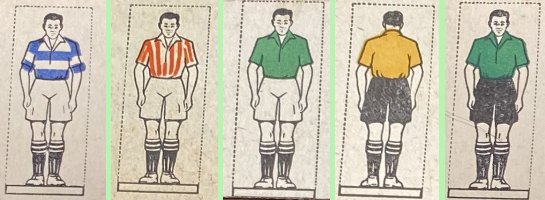
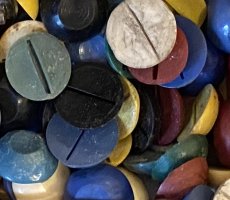
This season saw the production of the second full "price list of accessories and components". In this second version, the list reached Set "O". New items included deluxe fully assembled goals (Set N), and the first item that was not essential for play, a new Set L, the referee and linesmen team sheet. The "Super Flattened bases" were offered in two new colours: tangerine, and green (previously offered only as a goalkeeper base). The team colours list reached reference 16. The new base colours being for ref thirteen (tangerine/white) and ref fifteen (green/white) respectively. This list still had reference five listed as "black and white striped shirts, white shorts, but reference seven had become the familiar claret and sky of West Ham, Aston Villa, and Burnley.
Shown above are a range of the cut-out teams of the period - ref 11 (Peter Adolph's team Queens Park Rangers), ref 4, ref 15 and 6 (showing the back). The final figure is the goalkeeper for Queens Park Rangers, who in unusual, as he is a standard, short-sleeved player. The printed players are less cartoon-like than the original 1947 version, and this card design remained unchanged throughout the 1950s and '60s. The second picture shows a nice mix of "Super Flattened bases". Note that these do not have any Subbuteo markings at this early stage (and as usual with early bases, the plastic is suffering from fatigue).
The most important addition was Set "O", the final accessory in the range. These were the first celluloid teams, "stamped out in an unbreakable celluloid material". Initially, these were only available in the standard red/white, and blue/white colours.
Another interesting addition to the 1948-49 list was "The New Super Assembled" edition, complete with marked out pitch. Sadly, "owing to the difficulties of the times, the sale of the complete Super Assembled set is restricted to Exports abroad and for Educational purposes in the UK". Examples of organisations within the UK who were allowed to order the sets were schools, football clubs, youth clubs, scout troops, and Boy's Brigade companies. No price was given, but a brochure was available to those "who can enquire on their official headed note paper". This set did not reappear on any other price-list, until a mass-market version was introduced in the early 1950s.* (see below).
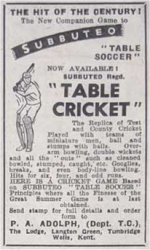
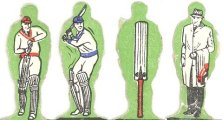
As mentioned, the second companion game, the wonderful "Subbuteo cricket" was released in January 1949. The set utilised the football bases, and the same shape figures, cleverly producing another playable game with minimal extra tooling or investment. The game was advertised heavily in comics and magazines over the summer months. The advert here came from Sport Magazine dated July 1949.
The 1949-50 Season
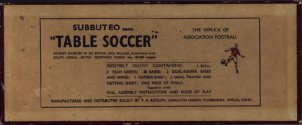
The final boxed set of the 1940s saw another tweak to the lid with the arrival of a colour logo, and further enhancements inside. The biggest change was the arrival of the press-out card teams. These were first mentioned in a mid-season reissue of the 1949-50 catalogue, dated to February 1950. The set I own (shown above) had press-out teams and paperwork, although it also had the earlier version of the 1949-50 catalogue.
However, to make things more complicated, I have also seen the logo on an earlier set, probably from the 1948-49 season. Sadly, this set did not have a price list to date it absolutely, but it did include an advertising brochure postmarked to January 1949. (type as shown below, on the right). As this was postmarked, it was clearly sent to the owner separately, and it can be assumed that he ordered the set from the information on the brochure. This set still had paperwork mentioning cut-out players, and had bases with no logos. It also had the 1948-49 rule book shown in that section (and a spin leaflet). However, the teams present in the set were press-out.
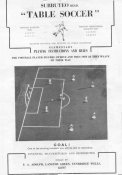
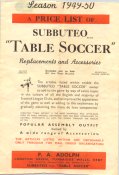
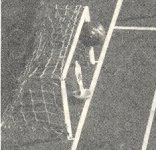
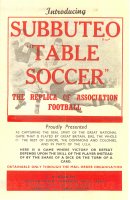
In the later 1949-50 set that I own, the rules had been reprinted (again). These now quoted two British patents (616782 and 616715) and two British registered design numbers (851000 and 853038). The other big difference was that the front cover picture had been retaken using updated Subbuteo equipment. The ball and figures were in near identical positions, but the ball, goal, and players were all now recognisable products, and the pitch was printed rather than drawn in chalk....Inside the booklet though, the rules were still unchanged, so the semi-circular shooting areas were still in the basic rules. However, the Spin! leaflet had the new version, as used at the 1948 Schoolboy Exhibition (i.e. nearer the opponents goal than the half-way line). The advanced booklet was unchanged this year, with the third edition not advertised until the 1950-51 catalogue.
The price list received three updates during this season. An "amendments and additions" list was issued in July 1949, and saw sets P to U introduced. That list also stated that the old team reference 5 (black and white shirts, white shorts) was not now stocked. However, reference 17 was introduced. The celluloid teams on set "O" were now available in all colours, and perhaps importantly, "now manufactured in a new lightweight plastic".
The full 1949-50 price list had an improved two-colour look, and a full table of team colours, now increased to twenty five strips. The third update (issued February 1950), saw in the new decade with press-out card teams available in refs 1, 2, 5 (new sky blue version), 15, and 18-24. The question must be whether 18-24 was ever done in cut-out figures, or whether this was just the point where Peter Adolph highlighted the difference.
The Belgian Editions.
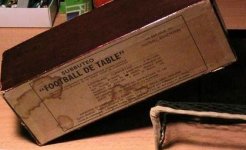
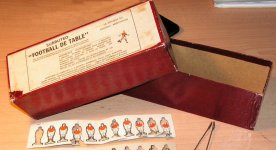
As mentioned earlier on this page, Peter Adolph stated that Subbuteo was "played extensively in Belgium" in his Advanced Soccer leaflet (second edition). These two pictures show "football de table" sets, with and without the kicking footballer logo. The older set (without the logo) still had cut-out teams, one of which was Belgium - red shirts, and black shorts. It is interesting to note that these two sets are in a deeper box than the British version, which allowed the goals to be stored once assembled.
The Super Assembled Set.
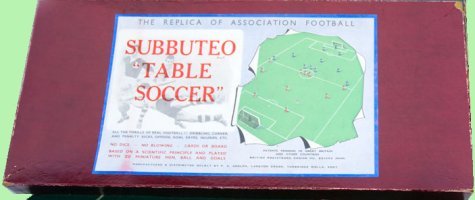
As mentioned above, the Super Assembled set was first advertised in 1948-49, but "restricted to Exports abroad and for Educational purposes in the UK". It then disappeared from the accessory lists until 1953. However, more investigation has shown that this set was available throughout the period. The set shown above had paperwork dated to 1949-50, and I know of a set from the previous year. Although the box looks very similar to the 1950s incarnation, there are differences. Firstly, the box is the lovely deep red of the other 1940s boxes. More importantly, the label states "patents pending in Great Britain and other countries". Later sets have the full patent details. This was the first set to feature the celluloid teams, and supply a pitch.
It is interesting to note that the illustrations on the label both date back to the 1947-48 paperwork. The photo under the words Subbuteo "Table Soccer" was first used on the TSPA handbook (it was Great Britain vs Rest of Europe from May 1947). The pitch illustration was very clearly based on the photo on the original "Advanced Table Soccer" leaflet - with regards to both the angle of pitch, and the position of the players.
[ Main Page ]